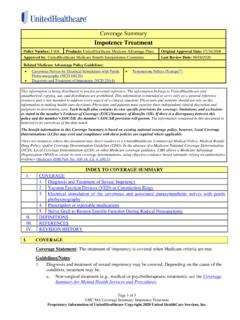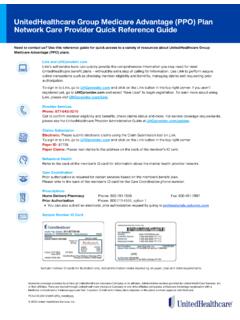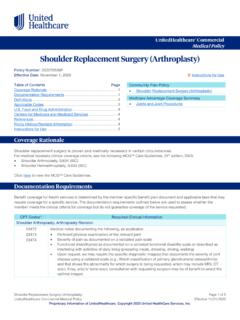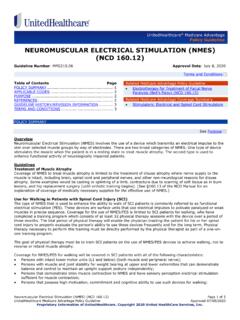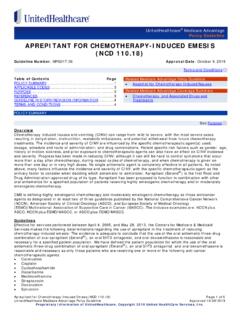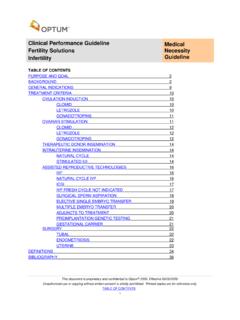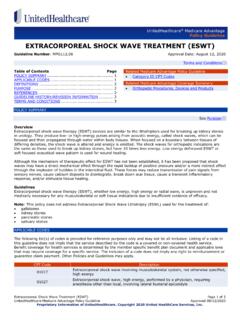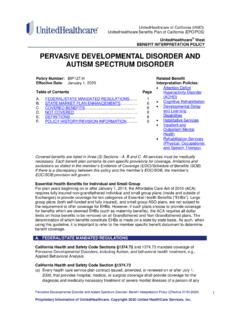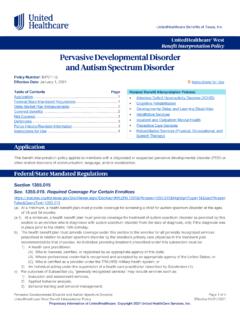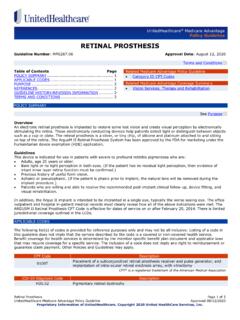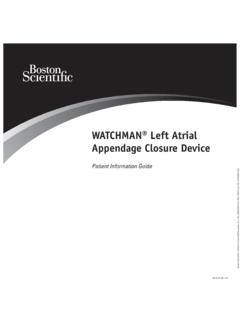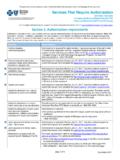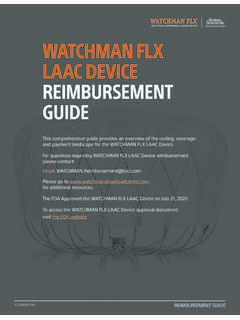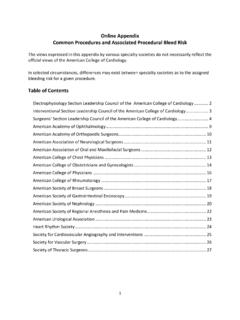Transcription of Percutaneous Left Atrial Appendage Closure (LAAC) (NCD 20 ...
1 Percutaneous Left Atrial Appendage Closure (LAAC) (NCD ) Page 1 of 6 UnitedHealthcare Medicare Advantage Policy Guideline Approved 06/09/2021 Proprietary Information of UnitedHealthcare. Copyright 2021 United HealthCare Services, Inc. UnitedHealthcare Medicare Advantage Policy Guideline Percutaneous Left Atrial Appendage Closure (LAAC) (NCD ) Guideline Number: Approval Date: June 9, 2021 Terms and Conditions Table of Contents Page Policy Summary .. 1 Applicable Codes .. 4 References .. 4 Guideline History/Revision Information .. 5 Purpose .. 5 Terms and Conditions .. 5 Policy Summary See Purpose Overview Patients with Atrial fibrillation (AF), an irregular heartbeat, are at an increased risk of stroke.
2 The left Atrial Appendage (LAA) is a tubular structure that opens into the left atrium and has been shown to be one potential source for blood clots that can cause strokes. While thinning the blood with anticoagulant medications has been proven to prevent strokes, Percutaneous LAA Closure (LAAC) has been studied as a non-pharmacologic alternative for patients with AF. Guidelines Nationally Covered Indications The Centers for Medicare & Medicaid Services (CMS) covers Percutaneous LAAC for non-valvular Atrial fibrillation (NVAF) through Coverage with Evidence Development (CED) with the following conditions: A.
3 LAAC devices are covered when the device has received Food and Drug Administration (FDA) Premarket Approval (PMA) for that device s FDA-approved indication and meet all of the conditions specified below: The patient must have: o A CHADS2 score 2 (Congestive heart failure, Hypertension, Age > 75, Diabetes, Stroke/transient ischemia attack/thromboembolism) or CHA2DS2-VASc score 3 (Congestive heart failure, Hypertension, Age 65, Diabetes, Stroke/transient ischemia attack/thromboembolism, Vascular disease, Sex category) o A formal shared decision making interaction with an independent non-interventional physician using an evidence-based decision tool on oral anticoagulation in patients with NVAF prior to LAAC.
4 Additionally, the shared decision making interaction must be documented in the medical record. o A suitability for short-term warfarin but deemed unable to take long-term oral anticoagulation following the conclusion of shared decision making, as LAAC is only covered as a second line therapy to oral anticoagulants. The patient (preoperatively and postoperatively) is under the care of a cohesive, multidisciplinary team (MDT) of medical professionals. The procedure must be furnished in a hospital with an established structural heart disease (SHD) and/or electrophysiology (EP) program. Related Medicare Advantage Policy Guidelines Category III CPT Codes Routine Costs in Clinical Trials (NCD ) Related Medicare Advantage Coverage Summaries Experimental Procedures and Items, Investigational Devices and Clinical Trials Transcatheter Heart Valve Procedures Percutaneous Left Atrial Appendage Closure (LAAC) (NCD ) Page 2 of 6 UnitedHealthcare Medicare Advantage Policy Guideline Approved 06/09/2021 Proprietary Information of UnitedHealthcare.
5 Copyright 2021 United HealthCare Services, Inc. The procedure must be performed by an interventional cardiologist(s), electrophysiologist(s), or cardiovascular surgeon (s) that meet the following criteria: Has received training prescribed by the manufacturer on the safe and effective use of the device prior to performing LAAC; and, Has performed 25 interventional cardiac procedures that involve transeptal puncture through an intact septum; and, Continues to perform 25 interventional cardiac procedures that involve transeptal puncture through an intact septum, of which at least 12 are LAAC, over a 2-year period.
6 The patient is enrolled in, and the MDT and hospital must participate in, a prospective, national, audited registry that: 1) consecutively enrolls LAAC patients, and, 2) tracks the following annual outcomes for each patient for a period of at least 4 years from the time of the LAAC: Operator-specific complications Device-specific complications including device thrombosis Stroke, adjudicated, by type Transient Ischemic Attack (TIA) Systemic embolism Death Major bleeding, by site and severity The registry must be designed to permit identification and analysis of patient, practitioner, and facility level factors that predict patient risk for these outcomes.
7 The registry must collect all data necessary to conduct analyses adjusted for relevant confounders, and have a written executable analysis plan in place to address the following questions: How do the outcomes listed above compare to outcomes in the pivotal clinical trials in the short term ( 12 months) and in the long term ( 4 years)? What is the long term ( 4 year) durability of the device? What are the short term ( 12 months) and the long term ( 4 years) device-specific complications including device thromboses? To appropriately address some of these questions, Medicare claims or other outside data may be necessary.
8 Registries must be reviewed and approved by CMS. Potential registry sponsors must submit all registry documentation to CMS for approval, including the written executable analysis plan and auditing plan. CMS will review the qualifications of candidate registries to ensure that the approved registry follows standard data collection practices, and collects data necessary to evaluate the patient outcomes specified above. The registry s national clinical trial number must be recorded on the claim. Consistent with section 1142 of the Social Security Act (the Act), the Agency for Healthcare Research and Quality (AHRQ) supports clinical research studies that CMS determines address the above-listed research questions and the criteria listed in Section c.
9 Of this decision. All approved registries will be posted on the CED website located at: B. LAAC is covered for NVAF patients not included in Section A of this decision when performed within an FDA approved randomized controlled trial (RCT) if such trials meet the criteria established below: As a fully-described written part of its protocol, the RCT must critically answer, in comparison to optimal medical therapy, the following questions: As a primary endpoint, what is the true incidence of ischemic stroke and systemic embolism? As a secondary endpoint, what is cardiovascular mortality and all-cause mortality?
10 Percutaneous Left Atrial Appendage Closure (LAAC) (NCD ) Page 3 of 6 UnitedHealthcare Medicare Advantage Policy Guideline Approved 06/09/2021 Proprietary Information of UnitedHealthcare. Copyright 2021 United HealthCare Services, Inc. FDA-approved RCTs must be reviewed and approved by CMS. Consistent with section 1142 of the Act, AHRQ supports clinical research studies that CMS determines address the above-listed research questions and the a-m criteria listed in Section c. of this decision. The principal investigator must submit the complete study protocol, identify the relevant CMS research question(s) that will be addressed, and cite the location of the detailed analysis plan for those questions in the protocol, plus provide a statement addressing how the study satisfies each of the standards of scientific integrity listed in section c.
